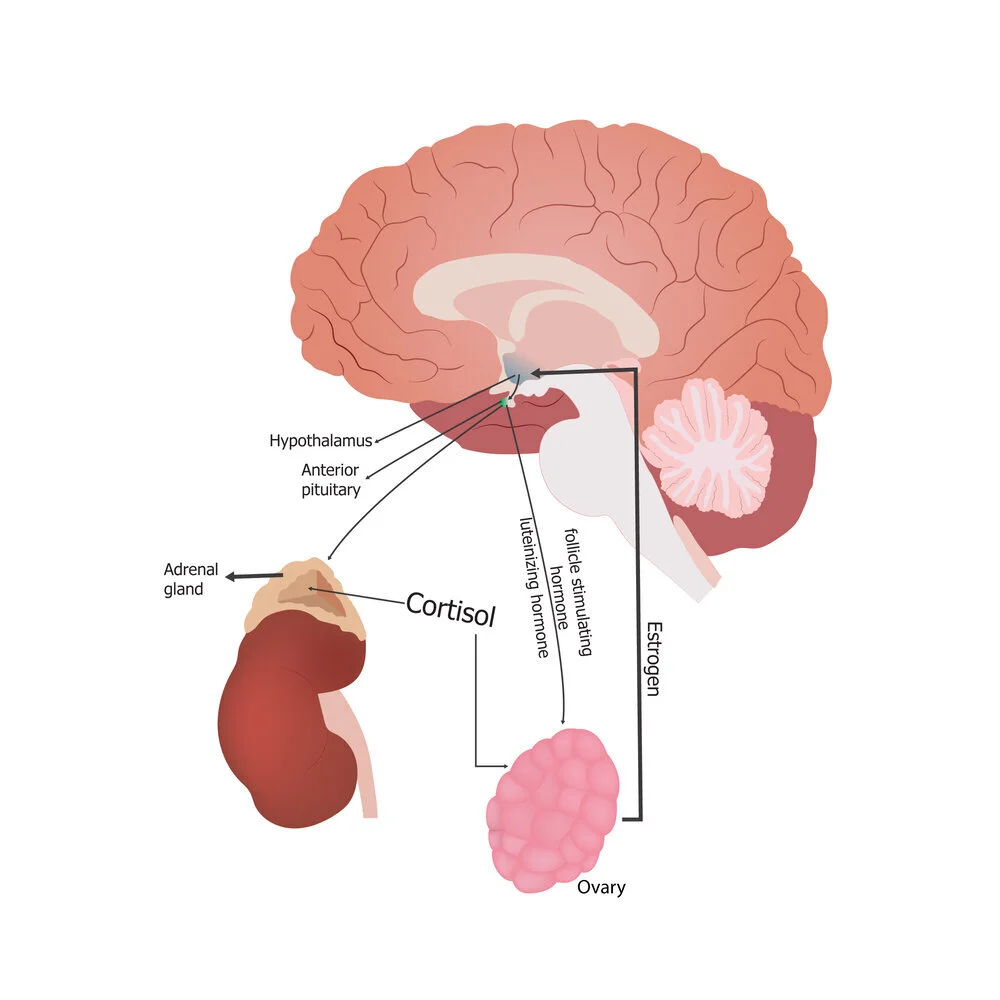YOUR HORMONES DURING A PANDEMIC, PART 2: ESTROGEN AND PROGESTERONE
THIS ARTICLE IS PART OF A SERIES AND BUILDS ON INFORMATION PRESENTED IN THE PREVIOUS ARTICLE. CLICK HERE TO READ PART 1: CORTISOL.
When cortisol is chronically elevated or it rises and falls at a more rapid pace than usual (AKA the stress you’re experiencing right now!), estrogen and progesterone production is affected. Here’s how:
Estrogen and progesterone are the stars of the reproductive cycle. But when your brain senses stress, cortisol production is prioritized. Cortisol dominates the stage energy, estrogen gets mad and throws a fit, and progesterone shuts down and cowers in a corner. Estrogen metabolism is less efficient and starts to cause more inflammation, and your ovaries get a signal to slow down progesterone production. Estrogen may crash as well with extended stress. The longer or more intense the stressor, the greater the suppression of estrogen and progesterone function, leading to all sorts of issues.
Repeated activation of the HPA axis (your stress response) represses ovulation, meaning you may or may not ovulate, or your ovulation may get pushed back a few days or weeks, extending your cycle much longer than normal. This is a big deal if you’re trying to get pregnant or have a normal hormone cycle. It’s especially noticeable in athletes and people prone to PCOS or eating disorders, as they are most likely to end up with non-cyclic anovulatory ovaries.
To make matters more interesting, women have a stronger HPA axis response than men. This is because our normal, higher estrogen and progesterone can trigger elevated stress hormone response to “normal” stressors. And since stress can change estrogen and progesterone production, it often triggers a downward spiraling cycle. What does this mean for you? It means that your typical “bad day” can create more immediate physical stress, making you want to burst into tears or eat a whole pizza. And trust me, it can happen to anyone.
Here’s a few more facts about estrogen and progesterone that might motivate you to act before they get whacky (or encourage them in the right direction if they are already acting up for you!).
Higher estrogen (within normal range) usually contributes to higher serotonin production. This is why it’s extremely common to have mood issue occur for the first time during menopause, when estrogen drops significantly. It’s also part of the reason why you feel so flat the first couple of days of your period.
High estradiol (one type of estrogen) supports normal dopamine levels, which is why women tend to respond better to SSRI antidepressants than men. As estradiol drops in menopause (or if your estrogen is too low due to chronic stress), you may become less responsive to SSRIs as well.
Lower estradiol is associated with avoidance of stressful events. So if you’ve already been under stress for a long time, you’ll probably find yourself avoiding any event or task that requires to you use a lot of mental or physical energy. So if you don’t feel like getting projects done, working out, or creating anything new right now, it’s totally understandable!
Progesterone regulates brain function, social behavior, and mood. When your progesterone is low right before your period and through your follicular phase, you’re less likely to want to see friends and you may feel more moody than usual. However, women with high progesterone throughout their cycle have more anxiety. So it’s complicated! Which is why you might need help if you don’t understand what’s going on with your hormones.
Chronic stress and low estrogen causes the HPA axis response to be minimized or delayed. Translation: Eventually, your stress response becomes less and less efficient. Which is a problem if you suddenly need to jump out of harm’s way or pivot your work to address an incoming crisis! This is often part of the picture in people with depression, anxiety, and PTSD.
What you can do about it:
REDUCE CORTISOL
If your estrogen and progesterone are whacked because of cortisol, you’ve got to start there. Read here to understand how to reduce cortisol and get your estrogen and progesterone back on track.
EAT SEEDS
Flax and sesame seeds are rich in phytoestrogens. Phytoestrogens are plant compounds that can function like estrogen in the body, as well as improve estrogen metabolism efficiency. If internal estrogen is too high, phytoestrogens can reduce it, but if estrogen is too low, phytoestrogens can mitigate the symptoms by mimicking estrogen function. Seeds also contain unsaturated fats that promote normal progesterone production.
EAT EDAMAME
Edamame is unprocessed soy bean, and is delicious in salads and stir-fries. I prefer edamame to tofu, because it is not processed at all (other than the shell removal). You can buy frozen edamame (shelled or unshelled) to use in your recipes. If you’re concerned about soy intake or are allergic/sensitive to soy, skip this option.
STOP SMOKING
You already know smoking isn’t good for you, but you might not know that it can inhibit estrogen production. The toxins in smoke impact your endocrine system, reducing the output of estrogen. There are obviously a host of benefits to smoking cessation, but consider this one as well.
AVOID EXCESSIVE EXERCISE
Cardio junkie? If you work out intensely, over 60 minutes, more than 4 days per week, you may want to change up your program. Athletes (even those with moderate or high body fat %) tend to have reduced estrogen production. And if your body fat percentage is low, you’re even more likely to have problems producing estrogen. This is because superficial fat in the legs, arms, and booty contribute to estrogen production. So if you’re in the habit of trying to shed a few pounds for summer, you may want to reconsider.
DRINK TEA
Green, black, red clover, and dong quai teas contain phytoestrogens or support estrogen production in other ways. Enjoy hot, iced, or as your smoothie base!
More resources:
If you suspect estrogen/progesterone imbalance, I highly recommend DUTCH hormone testing. It’s the most accurate test to determine your ability to produce reproductive hormones, and includes a bunch of variations so you get a clear picture of what’s going one. You’ll want to explore your DUTCH test with a qualified healthcare practitioner so you can optimize your understanding of the results. My coaching program for hormone balance does exactly that! We explore the data and develop a plan to put it into action. You can contact me here to learn more about how I can help you.
Trying to move well, but not feeling confident? The Body Positive Fitness Finder can help you connect with a fitness professional or facility close to you. P.S. I’m on there, too! I offer virtual and in-home training sessions, focused on you and your goals. Read here to learn more.
More articles you might like:
I’d love to hear your thoughts on this…how has the Covid19 pandemic affected YOUR hormones? Comment below or send me a message.
~ Sarah




